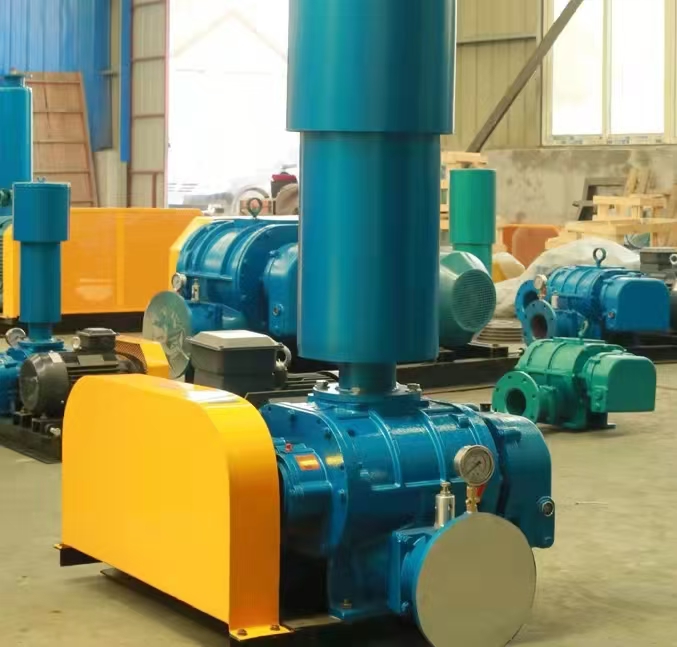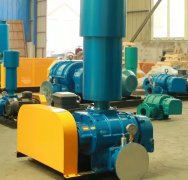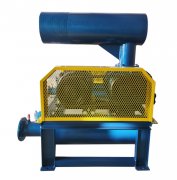**In depth analysis and solution of the cause of shaft breakage in Roots blower**
1、 Root cause classification of shaft breakage
1. * * Design defects * * (accounting for approximately 25%)
-Insufficient shaft diameter strength (coefficient<1.8)
-The transition fillet radius is too small (R<0.5mm)
-Stress concentration in keyway (without chamfering treatment)
2. * * Material issues * * (accounting for approximately 20%)
-The material grade does not match (such as using 45 steel instead of 42CrMo)
-Internal defects of forgings (inclusions, pores, etc.)
-Improper heat treatment (sudden change in hardness gradient)
3. * * Assembly error * * (accounting for approximately 30%)
-Poor alignment of coupling (deviation>0.05mm/m)
-Excessive pre tightening force on the bearing (clearance<0.02mm)
-Impeller dynamic balance exceeds the standard (G6.3 level or above)
4. * * Operating conditions * * (accounting for approximately 25%)
-Frequent start stop (>10 times/hour)
-Overpressure operation (>rated pressure 120)
-Resonance phenomenon (speed approaching critical speed)
2、 Analysis of typical broken shaft positions
|* * Fracture location * * | * * Proportion * * | * * Main causes * *|
|--------------------|----------|-------------------------------|
|Bearing position shoulder | 45 | Insufficient fillet+alternating stress|
|Root of keyway | 30 | Stress concentration+torque overload|
|Impeller connection thread | 15 | Thread retraction groove design defect|
|Mid axis | 10 | Material internal defects+resonance|
3、 Professional testing and diagnostic methods
1. Three elements of fracture analysis:
-Macroscopic examination (identifying fatigue sources through beach like patterns)
-Electron microscopy scanning (SEM analysis of intergranular fracture characteristics)
-Spectral analysis (detecting abnormal material composition)
2. Vibration spectrum analysis:
```math
\Text {fault characteristic frequency}=\ start {cases}
\Text {axis frequency}=\ frac {n} {60}\\
\Text {Bearing Failure Frequency}=f (FTF, BPFO, BPFI)\\
\Text {impeller passing frequency}=\ text {number of blades} \ times \ text {shaft frequency}
\end{cases}
```
3. * * Hardness testing standard * *:
|Axis segment position | Hardness requirement (C) | Testing method|
|----------------|----------------|----------------|
|Bearing position | 50-55 | Rockwell hardness tester|
|Keyway area | 40-45 | Leeb hardness tester|
|Shaft body | 28-32 | Brinell hardness tester|
4、 Preventive improvement measures
1. * * Design optimization plan * *:
-Increase the diameter of the dangerous section (coefficient ≥ 2.2)
-Adopting a variable diameter shaft structure (verified by finite element analysis)
-Surface strengthening of key parts (carburizing/nitriding treatment)
2. Manufacturing process control:
|Process steps | Control points | Standard basis|
|----------------|---------------------------|----------------|
|Forging | Forging ratio ≥ 4 | GB/T 12361|
|Heat treatment | Quenching and tempering hardness HB260-290 | JB/T 6396|
|Machining | Roughness Ra ≤ 1.6 μ m | ISO 1302|
3. * * Installation and Debugging Specifications * *:
-Laser alignment accuracy requirements:
```mermaid
graph LR
A [Radial deviation] -->| ≤ 0.02mm | B [Qualified]
A -->|>0.05mm | C [readjust]
```
-Bearing assembly interference tolerance:
|Shaft diameter (mm) | interference fit (mm)|
|----------|------------|
| 50-80 | 0.02-0.03 |
| 80-120 | 0.03-0.05 |
5、 Suggestions for operation and maintenance management
1. * * Monitoring threshold setting * *:
|Parameters | Warning Value | Shutdown Value|
|--------------|--------------|---------------|
|Vibration speed | 4.5mm/s | 7.1mm/s|
|Axle temperature | 85 ℃ | 95 ℃|
|Axial displacement | ± 0.3mm | ± 0.5mm|
2. * * Preventive Maintenance Plan * *:
-Every 2000 hours:
-Check the bending degree of the shaft (≤ 0.03mm/m)
-Ultrasonic testing (detecting internal defects)
-Every 8000 hours:
-Magnetic particle inspection (surface crack detection)
-Replace bearings (mandatory replacement)
6、 Typical Case Analysis
**A shaft breakage accident occurred in a chemical plant:
-Background: 55kW Roots blower experiences shaft failure after 3 months of operation
-Diagnostic process:
1. The fracture surface exhibits multi-source fatigue characteristics
2. The R angle at the root of the keyway is only 0.3mm
3. The vibration spectrum shows a prominent 2-fold frequency
-Root cause:
-Design flaw (insufficient R-angle)
-Defective alignment (radial deviation 0.08mm)
-Solution:
-Increase the shaft diameter by 10 (finite element verification)
-Switching to hydraulic couplings
-Add online vibration monitoring
7、 Suggestions for spare parts selection
1. * * Axis material selection * *:
|Working conditions | Recommended materials | Heat treatment requirements|
|--------------|----------------|-----------------|
|Ordinary | 42CrMo | Tempered HB260-290|
|Corrosion environment | 17-4PH | H1150 aging|
|Heavy Duty | 34CrNiMo6 | Carbonized and Quenched C55|
2. * * Bearing configuration * *:
-Recommended combination:
```mermaid
graph LR
A [Drive end] -->| NU type cylindrical roller | B [Bearing radial force]
C [Non driving end] -->| Angular contact ball bearing | D [Bearing axial force]
```
**Note * *: It is recommended to establish a full lifecycle file for shaft components, recording data from each stage of forging to scrapping. For critical equipment, it is recommended to use a condition monitoring system to achieve predictive maintenance. The new axle should undergo 200 hours of running in monitoring during its first operation.



